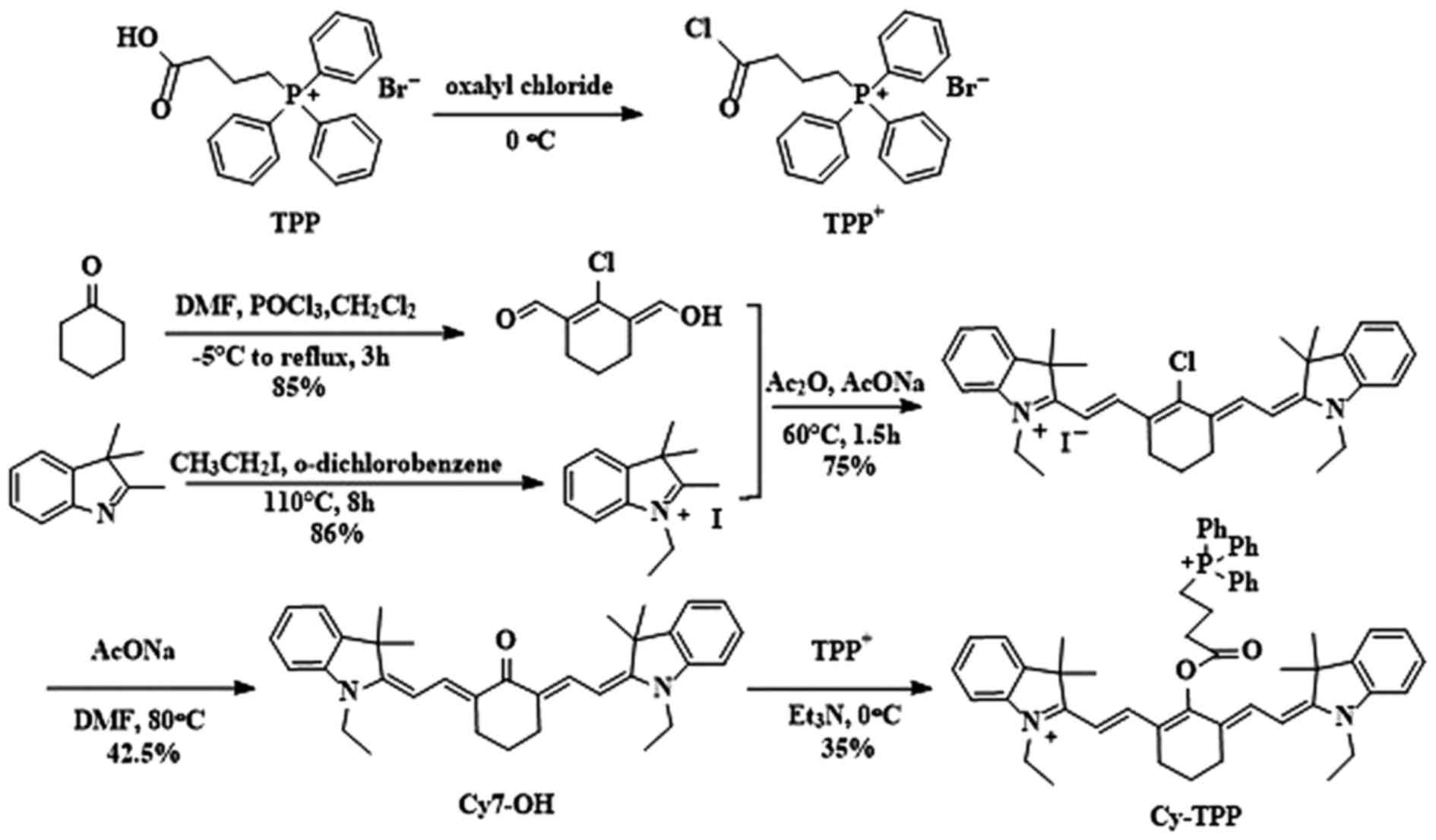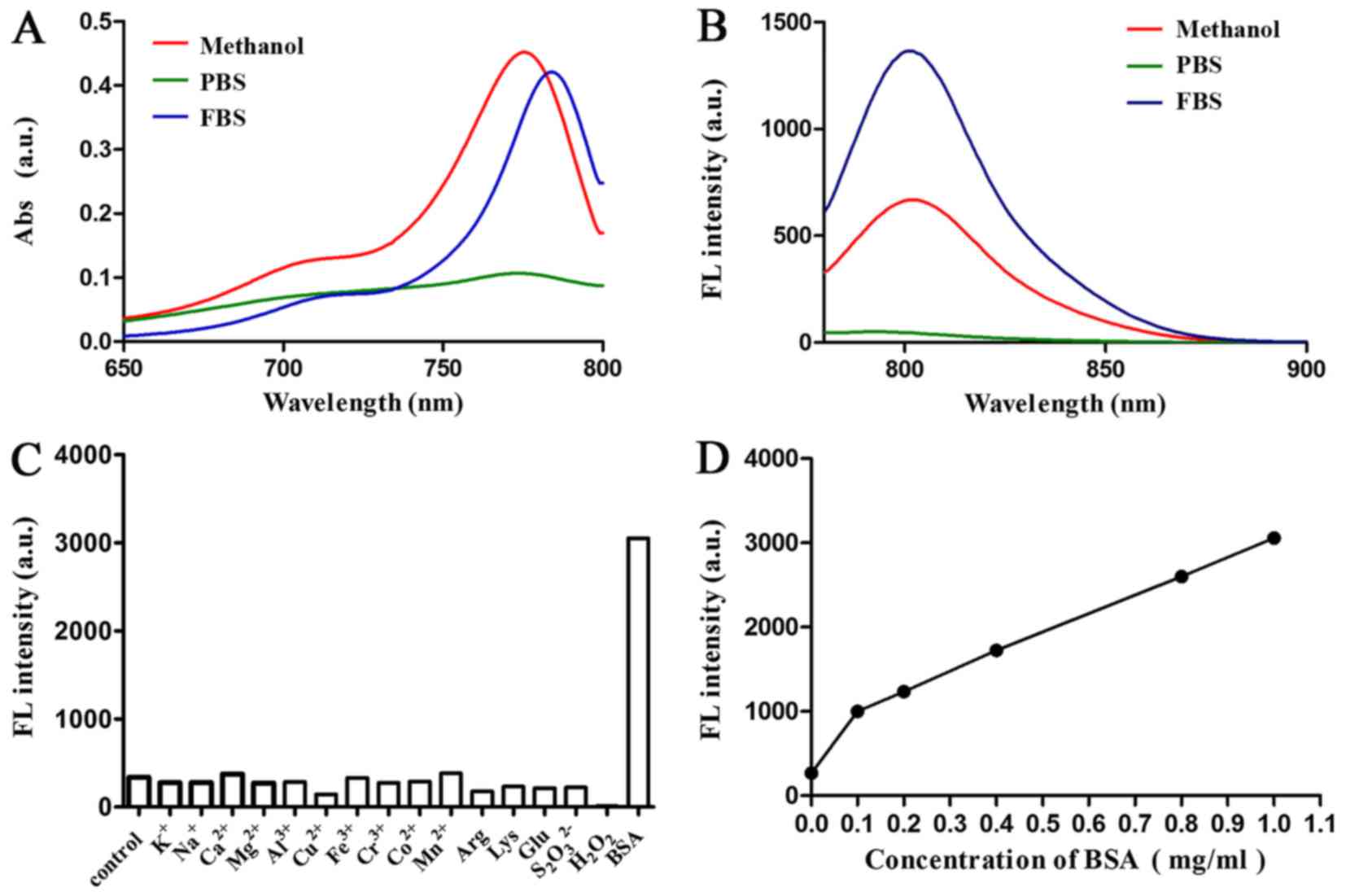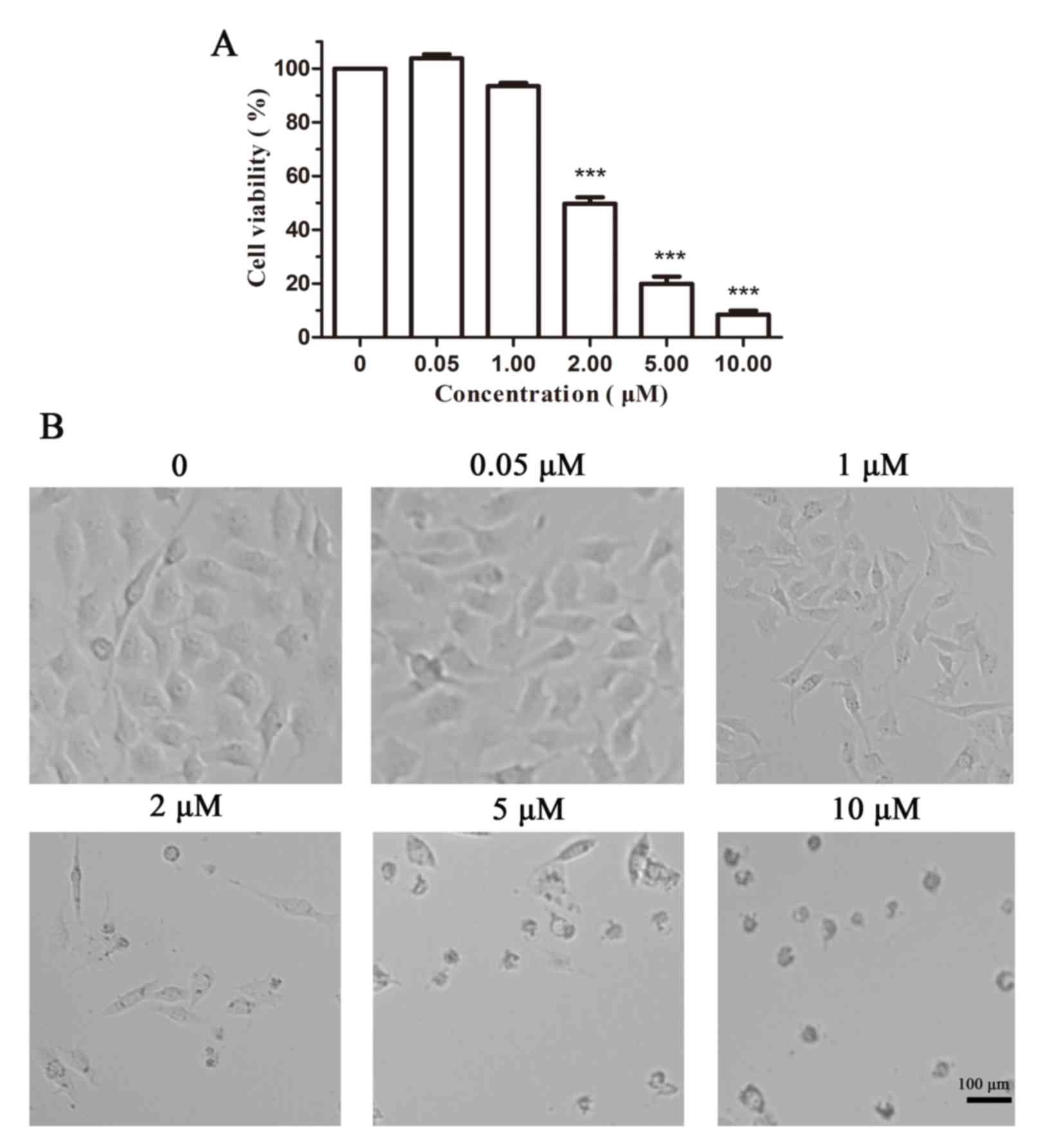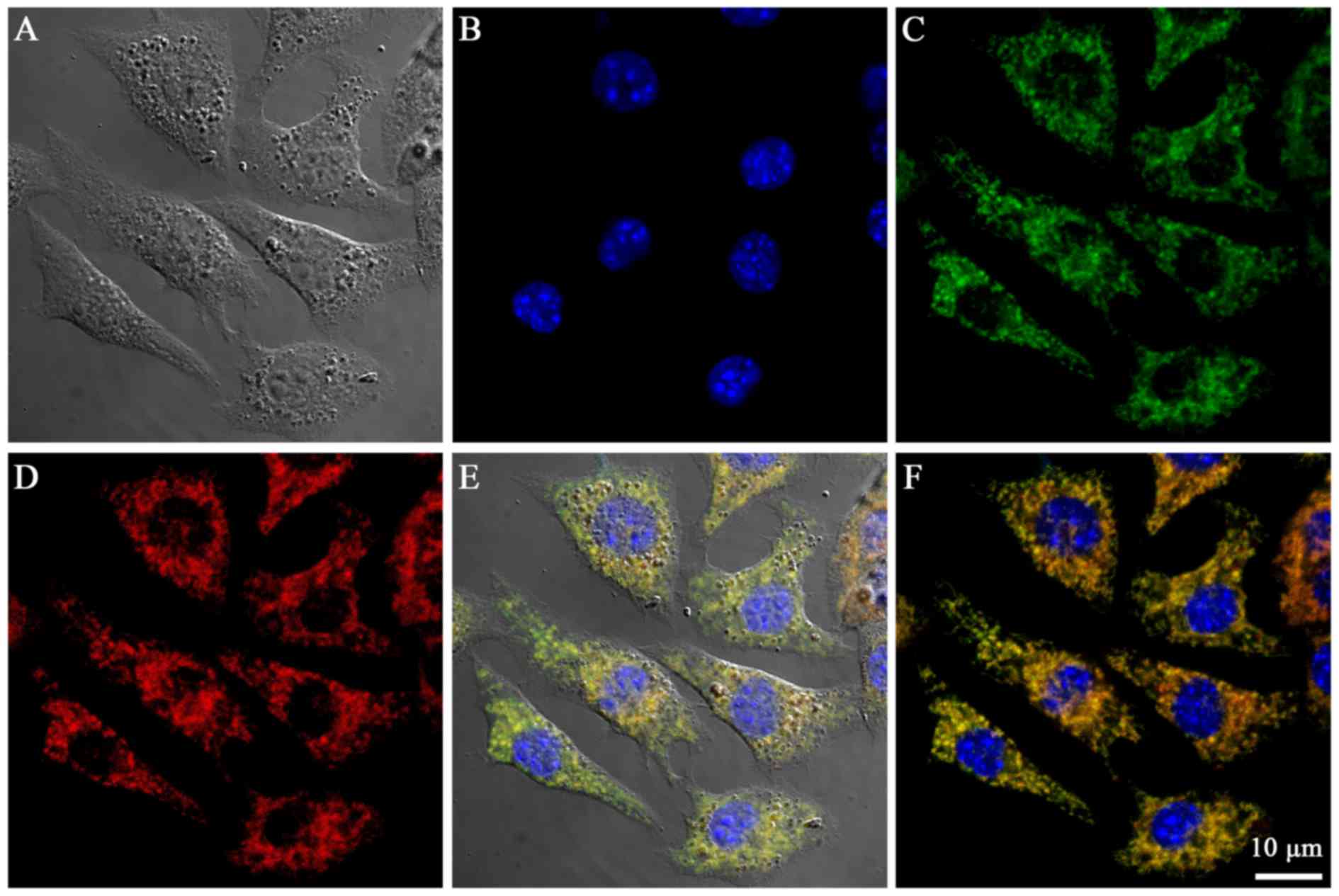Mitochondria targeting and near-infrared fluorescence imaging of a novel heptamethine cyanine anticancer agent
- Authors:
- Published online on: April 10, 2017 https://doi.org/10.3892/mmr.2017.6451
- Pages: 3761-3766
Abstract
Introduction
Cancer is a leading cause of human mortality worldwide, accounting for 12% of global mortality each year (1). An increasing body of evidence has demonstrated that the mitochondria may be a promising target for cancer therapy (2). A number of anticancer strategies associated with mitochondria-targeted imaging have been reported to be efficient, however, they have limited clinical application due to their low specificity for tumor targeting, lack of a sensitive modality to visualize therapeutic responses in real time and safety concern regarding their potential toxicity (3–5). Therefore, anticancer agents with tumor mitochondria-targeting and imaging are capabilities are in demand.
The mitochondrial membrane typically has a potential of −180 mV, which means positively charged molecules, including rhodamine and cyanine (Cy) dyes, easily traverse the plasma and mitochondrial membranes via the proton gradient (6) and accumulate in the mitochondria (7). Therefore, these molecules may represent an attractive agent for cancer mitochondria-targeted imaging. The near infrared (NIR) heptamethine Cy with anticancer activity has previously been verified for tumor targeting and imaging (8–11). Kim et al (12) conjugated the anticancer drug paclitaxel with NIR cyanine dye Cy5.5 labeled tumor-homing nanoparticles and demonstrated that these novel nanoparticles could be simultaneously applied in cancer diagnosis and treatment. In addition, IR-780 dye was revealed to specifically accumulate in the mitochondria of tumor cells and could be applied in tumor imaging with deep tissue penetration, high sensitivity and signal-to-noise ratio (13). However, its clinical application is still limited due to low anticancer activity and poor solubility.
The present study synthesized and screened a series of IR-780 analogs. In addition, the present study investigated the biochemical and biophysical characterization of the selected compound heptamethine Cy-triphenylphosphonium (Cy-TPP), and evaluated its optical properties, subcellular localization and anticancer activity.
Materials and methods
Chemicals and materials
Organic solvents were obtained from Chengdu KeLong Chemical Co., Ltd. (Chengdu, China) and were used directly without further purification unless specified. Anhydrous dichlormethane was further purified by distillation and was dried over molecular sieves prior to use. Aqueous solutions were all prepared using phosphate-buffered saline (PBS; pH 7.4). Cyclohexanone, 2,3,3-trimethylindolenine, iodoethane, oxalyl chloride, trimethylamine, oxalyl chloride and (3-carboxypropyl) triphenylphosphonium bromide were purchased from Shanghai Aladdin Biochemical Technology Co., Ltd. (Shanghai, China), and 2-(4,5-dimethyl-2-thiazolyl)-3,5-diphenyl-bromide (MTT) was obtained from Sigma-Aldrich; Merck KGaA (Darmstadt, Germany). The green fluorescent mitochondria tracker (MitoTracker® Green) and nucleic acid stain (Hoechst 33342) were purchased from Invitrogen; Thermo Fisher Scientific, Inc. (Waltham, MA, USA), and used according to the manufacturer's protocols. B16 melanoma cells were obtained from the American Type Culture Collection (Manassas, VA, USA).
Synthesis of Cy-OH
Cy7.Cl was synthesized by our laboratory according to the previously described method (14). The chemical structure was further identified by proton nuclear magnetic resonance spectroscopy (1HNMR; Bruker-400 MHz NMR; Bruker Corporation, Billerica, MA, USA) and Time of Flight Mass Spectrometer (TOF-MS; Agilent Technologies, Inc., Santa Clara, CA, USA). The chemical shifts of Cy7.Cl reported in ppm (DMSO-d6; TMS as internal standard) were as follows: 1HNMR (400 MHz, DMSO-d6) δ=8.27 (d, J=14.0 Hz, 2H), 7.65 (d, J=7.4 Hz, 2H), 7.53–7.38 (m, 4H), 7.30 (t, J=6.6 Hz, 2H), 6.33 (d, J=14.2 Hz, 2H), 4.26 (d, J=6.9 Hz, 4H), 2.73 (s, 4H), 1.89 (d, J=20.2 Hz, 2H), 1.67 (s, 12H), 1.31(t, J=7.1 Hz, 6H). TOF-MS: calculated for C34H40ClN2+, [M+H]+=512.1,575, found 512.2,881.
Cy7.Cl (639.0 mg, 1.0 mmol) and AcONa (820.0 mg, 10.0 mmol) were dissolved in 10 ml anhydrous N,N-dimethylformamide (DMF) under 100% nitrogen atmosphere for 3 h at 80°C. Then the mixture was washed three times with saturated KI solution, and extracted using CH2Cl2 (50 ml) for 3 times. All organic mixtures were dried using anhydrous sodium sulfate, concentrated on a rotary evaporator and the residues were purified by silica chromatography (500–800 mesh) eluted with petroleum ether: Ethyl acetate=1:1 (v/v) to give a dark red solid 209.0 mg. The yield of Cy-OH was 42.5% The H-shifts of Cy-OH were as follows: 1H NMR (400 MHz, DMSO-d6) δ 7.93 (d, J=13.3 Hz, 2H), 7.33 (d, J=7.2 Hz, 2H), 7.19 (t, J=8.0 Hz, 2H), 6.90 (dd, J=7.3, 4.4 Hz, 2H), 5.48 (d, J=13.4 Hz, 2H), 3.80 (dd, J=14.0, 7.0 Hz, 4H), 2.58–2.53 (t, 4H), 1.79–1.69 (m, 4H), 1.56 (s, 12H), 1.16(t, J=7.0 Hz, 6H). TOF-MS: Calculated for C34H40N2O, [M+H]+=492.7,070, found 492.7,128.
Synthesis of Cy-TPP
(3-Carboxypropyl) triphenylphosphonium Bromide (443.0 mg, 1.0 mmol) and 2 drops of DMF were dissolved in 10 ml anhydrous CH2Cl2, prior to the addition of chloroglyoxylate (1 ml). The mixture was stirred at 0°C for 4 h. Then the solvent was evaporated for further use without additional purification.
Under N2 conditions, Cy-OH (246.0 mg, 0.5 mmol) and triethylamine (50 µl) were dissolved in 5 ml anhydrous CH2Cl2. TPP+ (462.0 mg, 1.0 mmol) was dissolved in 5 ml anhydrous CH2Cl2 and added into the reaction mixture dropwise at 0°C for 30 min; the mixture was maintained at 25°C for 12 h. The mixture was washed 3 times with saturated KI solution, and extracted using CH2Cl2 (50 ml) for 3 times. The organic mixture solvent was dried using anhydrous sodium sulfate, evaporated on a rotary evaporator and the residues were purified by silica chromatography (500–800 mesh) eluted with dichloromethane:methanol (5:1, v/v) to give 164.5 mg of green solid. The yield of Cy-TPP was 35.0%. The H-shift of Cy-TPP were as follows: 1H NMR (400 MHz, DMSO-d6) δ 8.32 (d, J=13.3 Hz, 2H), 7.33–7.38 (m, 17H), 7.53–7.38 (t, J=8.0 Hz, 4H), 7.32 (d, J=7.3, 4.4 Hz, 2H), 6.34 (d, J=13.4 Hz, 2H), 4.27 (d, J=14.0, 7.0 Hz, 4H), 2.58–2.53 (t, 8H), 1.79–1.69 (m, 4H), 1.56 (s, 12H), 1.16 (t, J=7.0 Hz, 6H). TOF-MS: calculated for C56H61N2O2P2+, [M+H]+=825.0887, found 825.0596.
Optical properties of Cy-TPP
The UV-Vis absorption and fluorescence emission (B) spectra of Cy-TPP (2 µM) were conducted in MeOH, PBS and 100% FBS. Fluorescence spectra was obtained by fluorescence spectrometer (F7000 Fluorescence Spectrophotometer; Hitachi High-Technologies Corporation, Tokyo, Japan) with a Xenon lamp and 1.0-cm quartz cells at the slits of 5.0/5.0 nm. Absorption spectra was recorded by UV-Vis spectrophotometer (DU800; Beckman Coulter. Inc., Brea, CA, USA). The responses of Cy-TPP (5 µM) with different analytes (50 mM for K+, Na+, 10 mM for Arg, Lys, Glu, 1 mg/ml for BSA, 25 mM for Ca2+, Mg2+, Al3+, Cu2+, Fe3+, Cr3+, Co3+, Mn2+, S2O32−, H2O2) were conducted by incubating them for 30 min at 37°C and measured by fluorescence spectrometer. The fluorescence responses of Cy-TPP to various concentrations of BSA (0.1–1 mg/ml) were also measured by fluorescence spectrometer.
Cytotoxicity assay
In order to evaluate the cellular toxicity of different doses of Cy-TPP, the compound treated cells were illuminated using series of concentrations. Typically, B16 cells (5×104 cells/well) were cultured in RPMI-1640 medium (Hyclone; GE Healthcare Life Sciences, Logan, Utah, USA) supplemented with 10% fetal bovine serum (FBS; Hyclone; GE Healthcare Life Sciences) in an incubator with 5% CO2 at 37°C for 24 h. Prior to any experiments, the cell medium was removed and an increasing concentration (0.05, 1, 2, 5 and 10 µM) of probe Cy-TPP was added. The cells were then incubated for a further 24 h, and MTT assays were performed according to the manufacturer's instructions. Briefly, the medium was replaced with fresh medium containing 10% MTT (v/v). Following 3 h, the medium was replaced with 100 µl DMSO to solubilize the formed formazan. Absorption was measured at 490 nm for each well using a microplate reader. An untreated assay with RPMI-1640 was also conducted under the same conditions, which was recorded as the relative cell viability.
Confocal imaging
Fluorescent images were acquired on a confocal laser-scanning microscope (Nikon Eclipse Ti; Nikon Corporation, Tokyo, Japan) with an oil lens (magnification, ×60). B16 cells (5×104 cells/well) were plated in cell culture Petri-dishes (F=20 mm) in RPMI-1640 supplemented with 10% FBS in an incubator with 5% CO2 at 37°C. Following 24 h, the medium was removed and the cells were washed three times with PBS buffer. The cells were then incubated with the probe Cy-TPP (2.0 µM) in serum-free medium. Following 2 h, MitoTracker® Green (200 nM) was added, followed by Hoechst 33342 (1 µM). Following incubation for 15 min, the medium was removed. Cell imaging was carried out following cell washing with PBS three times to remove the excess compounds. Hoechst fluorescence was analyzed with an excitation at 405 nm and a scan range of 440 to 500 nm; MitoTracker Green fluorescence was analyzed with an excitation at 488 nm and a scan range of 520 to 570 nm; probe Cy-TPP was analyzed with an excitation at 770 nm and a scan range of 790 to 810 nm. Images were processed using Image Pro Plus 6.0 software (Media Cybernetics, Inc., Rockville, MD, USA).
Statistical analysis
All data are presented as the mean ± standard error of the mean. The data were analyzed by two-way analysis of variance followed by Dunnett's tests using GraphPad Prism 5 (GraphPad Software, Inc., La Jolla, CA, USA). P<0.05 was considered to indicate a statistically significant difference.
Results
Synthesis and structure characterization of Cy-TPP
Cy-TPP was designed and synthesized by adding TPP onto the Cy skeleton. The details of the synthetic routes and characterizations of Cy-TPP are outlined in Fig. 1. This design was chosen for two purposes. Firstly, it is well known that many lipophilic cations, such as TPP and Cy, possess an overall positive charge, which facilitates their uptake and accumulation in the mitochondria (15). Thus, heptamethine Cy was chosen as a signal transducer due to its favorable stability and NIR absorption and emission profile. Secondly, the TPP moiety has also been confirmed to be essential for antitumor activity (16). With an aim to increase the cytotoxic activity of heptamethine cyanine, TPP was used to enhance its lipophilic nature and cationic charge, which can facilitate the mitochondrial membrane potential dependent accumulation of TPP within the negatively charged mitochondrial matrix (17). The structure of Cy-TPP was identified by 1HNMR and MS.
Optical properties of Cy-TPP. The optical properties of Cy-TPP in methanol, 100% FBS and PBS were then determined (pH=7.4). The absorption and emission peaks of Cy-TPP were all in the NIR region (700 to 900 nm), providing 17 to 26 nm Stokes shifts (Fig. 2A and B). The fluorescence responses of Cy-TPP (5 mM) to various species, including K+, Na+, Ca2+, Mg2+, Al3+, Cu2+, Fe3+, Co2+, Mn2+, arginine, lysine, glucose and bovine serum albumin (BSA) was then investigated. The present study demonstrated that the fluorescence intensity of Cy-TPP markedly increased following the addition of BSA (Fig. 2C). Therefore, the effect of different doses of BSA on the fluorescence intensity of Cy-TPP was further investigated (Fig. 2D). Serum significantly increased the intensity fluorescence intensity of Cy-TPP, indicating it may have potential for biomedical application.
Cytotoxicity assay of Cy-TPP
An MTT assay in B16 cells was performed to evaluate the ability of Cy-TPP to inhibit cell proliferation. As displayed in Fig. 3A, the inhibition rate of cell viability in B16 cells incubated with 2.0 µM Cy-TPP was <50%, which is essential for its further applications in the anti-proliferation of cancer cells. Fig. 3B reveals cellular morphological alterations in B16 cells following the addition of Cy-TPP at doses 0–10 µM. An IC50, the half-maximal inhibitory concentration, value of 3.04 µM also indicated that Cy-TPP significantly inhibits the proliferation of B16 cells.
Subcellular localization of Cy-TPP
The mitochondria-targeting properties of the Cy-TPP were determined by incubating the probes with B16 cells (Fig. 4A-D). The confocal laser scanning microscopy analysis of the cells treated with Cy-TPP revealed accumulation in the mitochondria (Fig. 4E and F). Quantitative analysis using the Imagine-Pro Plus 6.0 ‘colocalization analysis’ tool revealed the significant colocalization of Cy-TPP with MitoTracker Green in the mitochondria of the cells (Pearson's correlation coefficient=8.1). The highly efficient mitochondrial targeting ability of Cy-TPP may be attributed to their high buffering capacity, which is generated by lipophilic TPP.
Discussion
The most recent strategy for developing anticancer agents with cancer mitochondria targeting and NIR fluorescence imaging is to conjugate a fluorescent probe with functional agents or materials (18). Heptamethine Cy dyes, which are associated with NIR absorption and mitochondria targeting, are promising candidates for cancer therapy and tumor imaging. Therefore, Cy dyes may be efficient as signal transducers to visualize therapeutic responses to anticancer drug in real time.
In our preliminary research, TPP moiety was demonstrated to be essential for mitochondria targeting and antitumor activity (16). Therefore, the aim of the present study was to conjugate the IR-780 analog Cy7-Cl with a TPP moiety to develop a novel mitochondria-targeted heptamethine Cy derivative. As expected, the novel compound Cy-TPP exhibited an NIR absorption and emission profile. Confocal laser scanning microscopy analysis indicated that Cy-TPP may specifically accumulate in the mitochondria. In addition, Cy-TPP significantly inhibited the proliferation of B16 cells (IC50=3.04 µM) in a concentration-dependent manner. The results of the present study demonstrated that Cy-TPP is a multifunctional agent for mitochondria-targeted imaging and cancer therapy, and suggest that Cy-TPP may be further developed to combat other limitations, including multidrug resistance (MDR). It has been previously demonstrated that MDR is significantly associated with poor success rates in the majority of anticancer drugs used in cancer treatments (19). It is widely accepted that lysosome-mediated clearance of anticancer drugs, such as doxorubicin, induces the development of MDR (20). However, mitochondria-targeted anticancer drugs directly exert their effect on the mitochondria, thereby evading clearance by lysosomes. Thus, the mitochondria-targeted heptamethine Cy derivative Cy-TPP may have the potential to reverse MDR.
In conclusion, the present study successfully designed and synthesized a mitochondria-targeted NIR visualized anticancer agent, Cy-TPP, with absorption and emission profiles located in the NIR region (600–900 nm). Subcellular localization and cell viability analysis demonstrated its mitochondria-targeted NIR imaging capability and efficient anti-proliferation effects (IC50=3.04 µM). In this regard, Cy-TPP may be a novel anticancer agent with mitochondria-targeting ability and can be visualized by NIR fluorescence imaging.
Acknowledgements
The present study was partly supported by the China National ‘12.5’ Foundation (grant no. 2011BAJ07B04) and the National Natural Science Foundation of China (grant no. 20972105).
References
|
Kumar R, Chaudhary K, Gupta S, Singh H, Kumar S, Gautam A, Kapoor P and Raghava GP: CancerDR: Cancer drug resistance database. Sci Rep. 3:14452013. View Article : Google Scholar : PubMed/NCBI | |
|
Strohecker AM and White E: Targeting mitochondrial metabolism by inhibiting autophagy in BRAF-driven cancers. Cancer Discov. 4:766–772. 2014. View Article : Google Scholar : PubMed/NCBI | |
|
Siegel R, Naishadham D and Jemal A: Cancer statistics, 2012. CA Cancer J Clin. 62:10–29. 2012. View Article : Google Scholar : PubMed/NCBI | |
|
Humphrey RW, Brockway-Lunardi LM, Bonk DT, Dohoney KM, Doroshow JH, Meech SJ, Ratain MJ, Topalian SL and Pardoll DM: Opportunities and challenges in the development of experimental drug combinations for cancer. J Natl Cancer Inst. 103:1222–1226. 2011. View Article : Google Scholar : PubMed/NCBI | |
|
Richards MA: The size of the prize for earlier diagnosis of cancer in England. Brit J Cancer. 101 Suppl 2:S125–S129. 2009. View Article : Google Scholar : PubMed/NCBI | |
|
Dickinson BC, Srikun D and Chang CJ: Mitochondrial-targeted fluorescent probes for reactive oxygen species. Curr Opin Chem Biol. 14:50–56. 2010. View Article : Google Scholar : PubMed/NCBI | |
|
Xu Z and Xu L: Fluorescent probes for the selective detection of chemical species inside mitochondria. Chem Commun (Camb). 52:1094–1119. 2016. View Article : Google Scholar : PubMed/NCBI | |
|
Zhang C, Liu T, Su Y, Luo S, Zhu Y, Tan X, Fan S, Zhang L, Zhou Y, Cheng T and Shi C: A near-infrared fluorescent heptamethine indocyanine dye with preferential tumor accumulation for in vivo imaging. Biomaterials. 31:6612–6617. 2010. View Article : Google Scholar : PubMed/NCBI | |
|
Yang X, Shi C, Tong R, Qian W, Zhau HE, Wang R, Zhu G, Cheng J, Yang VW, Cheng T, et al: Near IR heptamethine cyanine dye-mediated cancer imaging. Clin Cancer Res. 16:2833–2844. 2010. View Article : Google Scholar : PubMed/NCBI | |
|
Luo S, Zhang E, Su Y, Cheng T and Shi C: A review of NIR dyes in cancer targeting and imaging. Biomaterials. 32:7127–7138. 2011. View Article : Google Scholar : PubMed/NCBI | |
|
Tan X, Luo S, Wang D, Su Y, Cheng T and Shi C: A NIR heptamethine dye with intrinsic cancer targeting, imaging and photosensitizing properties. Biomaterials. 33:2230–2239. 2012. View Article : Google Scholar : PubMed/NCBI | |
|
Kim K, Kim JH, Park H, Kim YS, Park K, Nam H, Lee S, Park JH, Park RW, Kim IS, et al: Tumor-homing multifunctional nanoparticles for cancer theragnosis: Simultaneous diagnosis, drug delivery, and therapeutic monitoring. J Control Release. 146:219–227. 2010. View Article : Google Scholar : PubMed/NCBI | |
|
Majumdar D, Peng XH and Shin DM: The medicinal chemistry of theragnostics, multimodality imaging and applications of nanotechnology in cancer. Curr Top Med Chem. 10:1211–1226. 2010. View Article : Google Scholar : PubMed/NCBI | |
|
Wang X, Sun J, Zhang W, Ma X, Lv J and Tang B: A near-infrared ratiometric fluorescent probe for rapid and highly sensitive imaging of endogenous hydrogen sulfide in living cells. Chem Sci. 4:2551–2556. 2013. View Article : Google Scholar | |
|
Xu W, Teoh CL, Peng J, Su D, Yuan L and Chang YT: A mitochondria-targeted ratiometric fluorescent probe to monitor endogenously generated sulfur dioxide derivatives in living cells. Biomaterials. 56:1–9. 2015. View Article : Google Scholar : PubMed/NCBI | |
|
Pathania D, Millard M and Neamati N: Opportunities in discovery and delivery of anticancer drugs targeting mitochondria and cancer cell metabolism. Adv Drug Deliv Rev. 61:1250–1275. 2009. View Article : Google Scholar : PubMed/NCBI | |
|
Ross MF, Kelso GF, Blaikie FH, James AM, Cochemé HM, Filipovska A, Da Ros T, Hurd TR, Smith RA and Murphy MP: Lipophilic triphenylphosphonium cations as tools in mitochondrial bioenergetics and free radical biology. Biochemistry (Mosc). 70:222–230. 2005. View Article : Google Scholar : PubMed/NCBI | |
|
Tan X, Luo S, Wang D, Su Y, Cheng T and Shi C: A NIR heptamethine dye with intrinsic cancer targeting, imaging and photosensitizing properties. Biomaterials. 33:2230–2239. 2012. View Article : Google Scholar : PubMed/NCBI | |
|
Saw PE, Park J, Jon S and Farokhzad OC: A drug-delivery strategy for overcoming drug resistance in breast cancer through targeting of oncofetal fibronectin. Nanomedicine. 13:713–722. 2017. View Article : Google Scholar : PubMed/NCBI | |
|
Zhitomirsky B and Assaraf YG: Lysosomes as mediators of drug resistance in cancer. Drug Resist Updat. 24:23–33. 2016. View Article : Google Scholar : PubMed/NCBI |













